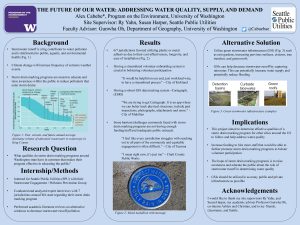THE FUTURE OF OUR WATER: ADDRESSING WATER QUALITY, SUPPLY, AND DEMAND
Water quality issues are a constant issue as rain can pick up pollutants, overwhelm combined sewer systems, and flush out illegally dumped fluids. In addition, water demand continues to increase, as water supply decreases due to climate change as extreme precipitation events and extreme droughts become more frequent and the increasing population in urban areas drive up demand. Therefore, solutions in raising awareness within communities about the changing climate, significance of stormwater runoff and storm drains, and importance of capturing stormwater are important in addressing this problem. Seattle Public Utilities (SPU) plans to reestablish their storm drain marking program to educate and raise public awareness. The purpose of this study was to investigate qualities of an effective volunteer storm drain marking program to aid in reestablishing SPU program and to determine solutions to collect stormwater to decrease urban stormwater runoff and increase water supply. To accomplish this task, I worked with SPU and conducted expert interviews from different jurisdictions around Washington state regarding their volunteer storm drain marking programs and conducted academic literature reviews. Findings showed that utilizing plastic adhesives with messaging saying variations around ‚ “No Dumping‚” and, “Drains to Sound”, having a streamlined onboarding process of volunteers, and having a GIS data management strategy in place leads to an effective volunteer storm drain marking program while applying green stormwater infrastructure such as trees, rain gardens, and cisterns within public infrastructures, homes, and businesses can be an effective solution in capturing rainwater to decrease urban runoff and increase water supply.
